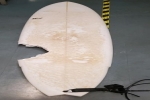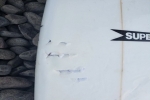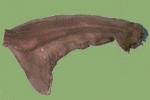Shark Warning Signs up at Maui’s Honolua Bay after Morning Incident
News Release Department of Land and Natural Resources (DLNR) 08. December 2020 — — — — — — — — — — — (HONOLULU) – Shark warning signs are up on either side of Honolua Bay after a man encountered a shark this morning. The signs are placed, one mile on either side of the
Surfer Suffers Non-Life Threating Injuries after Shark Bite
Press Release City of Seaside, Ore. 06. December 2020 —- —– —- —- —- —- —- On Sunday, December 6, 2020 at approximately 3:26 p.m., Seaside Fire & Rescue was dispatched to a report of a shark bite victim in the area of the Seaside Cove. Both Seaside Fire and a local Medix crew arrived at
Shark fins: Call for evidence on protecting endangered shark species launches
Press Release UK Department for Environment, Food & Rural Affairs The Rt Hon Lord Zac Goldsmith 06. December 2020 — — — — — — — — — — — Government launches call for evidence on shark fin trade to look at the impact of stricter controls Greater protections for species of sharks will be
Variation of body condition and plasma energy substrates with life stage, sex, and season in wild‐sampled nurse sharks
Variation of body condition and plasma energy substrates with life stage, sex, and season in wild‐sampled nurse sharks Ginglymostoma cirratum Shannon G. Moorhead, Austin J. Gallagher, Liza Merly, Neil Hammerschlag ABSTRACT: Reported here are the relationships among morphological (i.e., body condition) and biochemical (i.e., plasma concentrations of triglycerides, cholesterol, free fatty acids, and ketone bodies
A new synapomorphy in the pelvic girdle reinforces a close relationship of Zanobatus and Myliobatiformes
A new synapomorphy in the pelvic girdle reinforces a close relationship of Zanobatus and Myliobatiformes (Chondrichthyes: Batoidea) João Paulo Capretz Batista da Silva, Thiago Silva Loboda, Ricardo de Souza Rosa ABSTRACT: The rays of the order Myliobatiformes present several diagnostic characters, the most striking one being the presence of a serrated sting on the dorsal
The current knowledge gap on metallothionein mediated metal-detoxification in Elasmobranchs
The current knowledge gap on metallothionein mediated metal-detoxification in Elasmobranchs Rachel Ann Hauser-Davis ABSTRACT: Elasmobranchs are particularly vulnerable to environmental contamination, especially pollutants that may bioaccumulate and biomagnify, throughout the trophic web, such as metals. However, Elasmobranch management and conservation plans are challenging, and this group is often neglected regarding ecotoxicological analyses, particularly concerning metal
Mercury screening in highly consumed sharpnose sharks
Mercury screening in highly consumed sharpnose sharks (Rhizoprionodon lalandii and R. porosus) caught artisanally in southeastern Brazil Catarina Amorim-Lopes, Isabel Q. Willmer, Nathan L. F. Araujo, Lucia Helena S. de S. Pereira, Fernanda Monteiro, Rafael C. C. Rocha, Tatiana D. Saint’Pierre, Luciano N. dos Santos, Salvatore Siciliano, Marcelo Vianna, Rachel Ann Hauser-Davis ABSTRACT: Sharpnose sharks
Effects of nasal parasite species in the small-spotted catshark
Effects of nasal parasite species in the small-spotted catshark Scyliorhinus canicula (Scyliorhinidae; Carcharhiniformes) Stefano Aicardi, Andrea Amaroli, Lorenzo Gallus, Sara Ferrando ABSTRAC: The presence of the parasitic copepod Neoalbionella globosa in the olfactory chamber of a specimen of the catshark Scyliorhinus canicula has been already reported in the literature, but this is the first record






